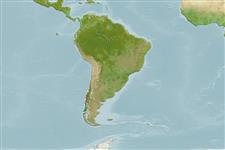Lớp cá viên khẩu (Myxini) (hagfishes) >
Myxiniformes (Hagfishes) >
Myxinidae (Hagfishes) > Eptatretinae
Etymology: Eptatretus: hepta (Gr.), seven; tretos (Gr.), perforated (i.e., with holes), referring to seven gill apertures on what would later be described as Homea banksii (=E. cirrhatus) [range within genus is 6-14 pairs of gill apertures] (See ETYFish); polytrema: poly- (Gr.), many; trema (Gr.), hole, referring to 16 gill apertures per side (See ETYFish).
More on author: Girard.
Environment: milieu / climate zone / depth range / distribution range
Sinh thái học
Biển gần đáy; không di cư; Mức độ sâu 10 - 350 m (Ref. 31276). Deep-water; 30°S - 42°S
Southeast Pacific: Chile (from Coquimbo to Puerto Montt, Ref. 34263).
Bộ gần gũi / Khối lượng (Trọng lượng) / Age
Maturity: Lm ? range ? - ? cm
Max length : 93.0 cm TL con đực/không giới tính; (Ref. 31276)
TBK: demerspelag.
Life cycle and mating behavior
Chín muồi sinh dục | Sự tái sinh sản | Đẻ trứng | Các trứng | Sự sinh sản | Ấu trùng
Copulatory organ absent. The gonads of hagfishes are situated in the peritoneal cavity. The ovary is found in the anterior portion of the gonad, and the testis is found in the posterior part. The animal becomes female if the cranial part of the gonad develops or male if the caudal part undergoes differentiation. If none develops, then the animal becomes sterile. If both anterior and posterior parts develop, then the animal becomes a functional hermaphrodite. However, hermaphroditism being characterised as functional needs to be validated by more reproduction studies (Ref. 51361 ).
Fernholm, B., 1998. Hagfish systematics. p. 33-44. In J.M. Jørgensen, J.P. Lomholt, R.E. Weber and H. Malte (eds.) The biology of hagfishes. Chapman & Hall, London. 578 p. (Ref. 31276)
IUCN Red List Status (Ref. 130435: Version 2024-2)
Threat to humans
Harmless
Human uses
Các nghề cá: không ích lợi (thú vị)
Các công cụ
Special reports
Download XML
Các nguồn internet
Estimates based on models
Preferred temperature (Ref.
123201): 10.5 - 11.8, mean 11.1 °C (based on 8 cells).
Phylogenetic diversity index (Ref.
82804): PD
50 = 0.5000 [Uniqueness, from 0.5 = low to 2.0 = high].
Bayesian length-weight: a=0.00389 (0.00211 - 0.00719), b=2.92 (2.74 - 3.10), in cm total length, based on LWR estimates for this species & (Sub)family-body (Ref.
93245).
Mức dinh dưỡng (Ref.
69278): 4.4 ±0.7 se; based on size and trophs of closest relatives
Generation time: 8.9 ( na - na) years. Estimated as median ln(3)/K based on 1
growth studies.
Thích nghi nhanh (Ref.
120179): thấp, thời gian nhân đôi của chủng quần tối thiểu là 4.5 - 14 năm (Fec assumed to be <100).
Fishing Vulnerability (Ref.
59153): High vulnerability (62 of 100).
Nutrients (Ref.
124155): Calcium = 10.4 [2.7, 33.2] mg/100g; Iron = 0.333 [0.119, 0.906] mg/100g; Protein = 2.72 [0.00, 6.54] %; Omega3 = 0.259 [0.101, 0.676] g/100g; Selenium = 13.2 [3.9, 44.3] μg/100g; VitaminA = 9.6 [2.0, 44.9] μg/100g; Zinc = 0.307 [0.153, 0.589] mg/100g (wet weight);
